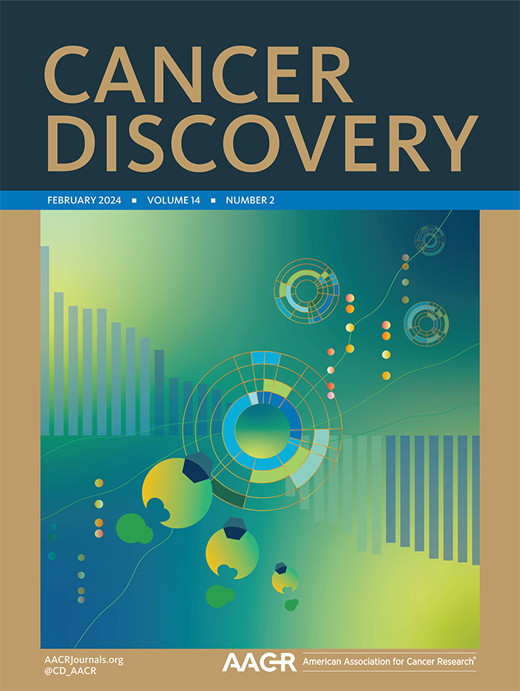整合ctDNA分析和放射组学用于局部肺癌的动态风险评估
IF 33.3
1区 医学
Q1 ONCOLOGY
引用次数: 0
摘要
液体活检和放射图像分析相结合的互补性和临床应用尚未得到证实。非小细胞肺癌(NSCLC)的放化疗后ctDNA最小残留病(CRT)是高度预后的,但需要治疗中的生物标志物来实现反应适应治疗。在这项研究中,我们分析了418例接受CRT治疗的非小细胞肺癌患者,以开发和验证一种新的动态风险模型,该模型可以准确预测治疗期间的最终无进展生存期。我们优化了来自血浆样本的无组织变异呼叫,以促进ctDNA监测,并证明了考虑持续克隆造血变异的重要性。我们发现,crt中期ctDNA浓度是疾病进展的预后因素,并将其他crt前危险因素(包括放射组学)整合到一个改善预后预测的组合模型中。我们的研究结果表明,肿瘤特征、放射组学和中期crt ctDNA分析是互补的,可以识别高风险和低风险的进展患者,从而潜在地实现反应适应治疗。意义:本研究表明,结合肿瘤特征、放射组学和ctDNA分析可以改善非小细胞肺癌CRT治疗的预后预测。我们的综合模型可以实现个性化和反应适应疗法,以减少毒性并改善患者的预后。本文章由计算机程序翻译,如有差异,请以英文原文为准。
Integrating ctDNA Analysis and Radiomics for Dynamic Risk Assessment in Localized Lung Cancer
The complementarity and clinical utility of combining liquid biopsies and radiomic image analysis has not been demonstrated. ctDNA minimal residual disease after chemoradiotherapy (CRT) for non–small cell lung cancer (NSCLC) is highly prognostic, but on-treatment biomarkers are needed to enable response-adapted therapies. In this study, we analyzed 418 patients with NSCLC undergoing CRT to develop and validate a novel dynamic risk model that accurately predicts ultimate progression-free survival during treatment. We optimize tissue-free variant calling from plasma samples to facilitate ctDNA monitoring and demonstrate the importance of accounting for persistent clonal hematopoiesis variants. We show that mid-CRT ctDNA concentration is prognostic for disease progression and integrate additional pre-CRT risk factors, including radiomics, into a combined model that improves outcome prediction. Our results suggest that tumor features, radiomics, and mid-CRT ctDNA analysis are complementary and can identify patients at high and low risk of progression to potentially enable response-adapted therapies. Significance: This study demonstrates that combining tumor features, radiomics, and ctDNA analysis improves outcome prediction in NSCLC treated with CRT therapy. Our integrated model could enable personalized and response-adapted therapies to reduce toxicity and improve outcomes in patients.
求助全文
通过发布文献求助,成功后即可免费获取论文全文。
去求助
来源期刊

Cancer discovery
ONCOLOGY-
CiteScore
22.90
自引率
1.40%
发文量
838
审稿时长
6-12 weeks
期刊介绍:
Cancer Discovery publishes high-impact, peer-reviewed articles detailing significant advances in both research and clinical trials. Serving as a premier cancer information resource, the journal also features Review Articles, Perspectives, Commentaries, News stories, and Research Watch summaries to keep readers abreast of the latest findings in the field. Covering a wide range of topics, from laboratory research to clinical trials and epidemiologic studies, Cancer Discovery spans the entire spectrum of cancer research and medicine.
 求助内容:
求助内容: 应助结果提醒方式:
应助结果提醒方式:


